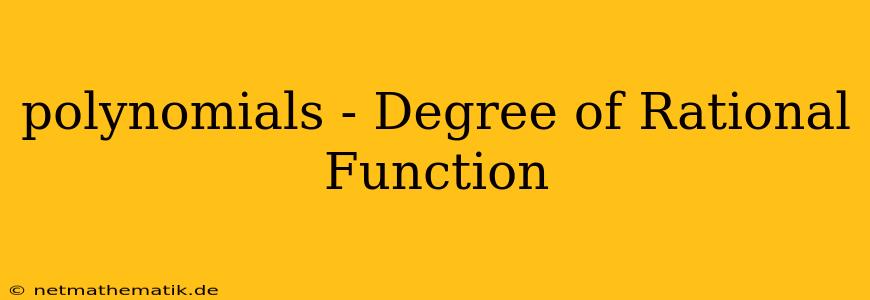The degree of a rational function, a function expressed as the ratio of two polynomials, plays a crucial role in understanding its behavior, especially its end behavior and the existence of any horizontal or oblique asymptotes. This article delves into the concept of the degree of a rational function and its implications, providing a comprehensive guide for understanding this fundamental aspect of rational function analysis.
Understanding the Degree of a Rational Function
A rational function is defined as the quotient of two polynomial functions, where the denominator cannot be zero. In the standard form, a rational function is represented as:
$f(x) = \frac{p(x)}{q(x)}$
where $p(x)$ and $q(x)$ are polynomials. The degree of a rational function is determined by comparing the degrees of the numerator and denominator polynomials.
- Degree of the Numerator: The degree of the numerator polynomial, denoted as $m$, is the highest power of the variable $x$ in the numerator, $p(x)$.
- Degree of the Denominator: Similarly, the degree of the denominator polynomial, denoted as $n$, is the highest power of the variable $x$ in the denominator, $q(x)$.
Determining the Degree
To determine the degree of a rational function, we simply compare the degrees of the numerator and denominator:
-
Case 1: Degree of Numerator > Degree of Denominator (m > n)
- The degree of the rational function is m - n.
- This type of rational function has an oblique asymptote (also known as a slant asymptote).
-
Case 2: Degree of Numerator < Degree of Denominator (m < n)
- The degree of the rational function is n - m.
- This type of rational function has a horizontal asymptote at y = 0.
-
Case 3: Degree of Numerator = Degree of Denominator (m = n)
- The degree of the rational function is 0.
- This type of rational function has a horizontal asymptote at y = the ratio of the leading coefficients of the numerator and denominator polynomials.
Examples
Let's illustrate these concepts with examples:
Example 1:
Consider the rational function:
$f(x) = \frac{2x^3 + 5x - 1}{x^2 + 3}$
- Degree of the numerator (m): 3
- Degree of the denominator (n): 2
Since the degree of the numerator is greater than the degree of the denominator (m > n), the degree of the rational function is 3 - 2 = 1. This indicates that the function has an oblique asymptote.
Example 2:
Let's analyze another rational function:
$f(x) = \frac{x^2 - 4x + 3}{x^3 + 2x}$
- Degree of the numerator (m): 2
- Degree of the denominator (n): 3
Here, the degree of the numerator is less than the degree of the denominator (m < n). Therefore, the degree of the rational function is 3 - 2 = 1. This means the function has a horizontal asymptote at y = 0.
Example 3:
Now, examine this rational function:
$f(x) = \frac{4x^2 - 2x + 1}{3x^2 + 5}$
- Degree of the numerator (m): 2
- Degree of the denominator (n): 2
In this case, the degrees of the numerator and denominator are equal (m = n). The degree of the rational function is 0. This indicates the function has a horizontal asymptote at y = 4/3, which is the ratio of the leading coefficients of the numerator and denominator.
Importance of the Degree
The degree of a rational function provides valuable information about the function's behavior:
- End Behavior: The degree helps predict how the function behaves as $x$ approaches positive or negative infinity. For instance, if the degree is positive, the function might grow without bound as $x$ approaches infinity.
- Asymptotes: The degree plays a key role in determining the existence and location of horizontal or oblique asymptotes. Asymptotes are lines that the graph of the function approaches as $x$ approaches infinity or negative infinity.
Applications
The concept of the degree of a rational function finds applications in various fields:
- Calculus: Understanding the degree is crucial for finding limits, derivatives, and integrals of rational functions.
- Physics: Rational functions are used to model various physical phenomena, such as the motion of objects and the distribution of charges.
- Engineering: Rational functions are employed in circuit analysis, control systems, and other engineering disciplines.
Conclusion
The degree of a rational function is a fundamental concept that provides insights into the behavior and characteristics of these functions. By comparing the degrees of the numerator and denominator polynomials, we can determine the function's degree, identify the presence of asymptotes, and predict its end behavior. This knowledge is essential for a deeper understanding and analysis of rational functions across diverse fields of study.
